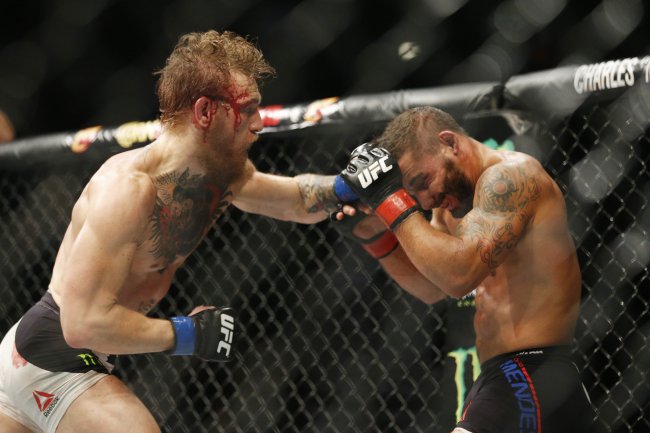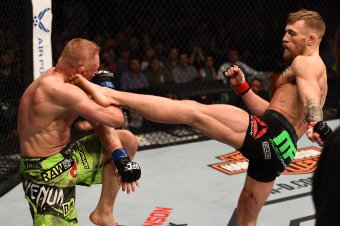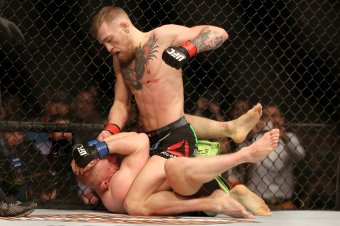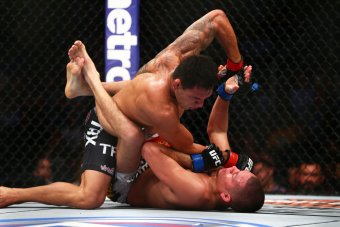When a broken foot forced lightweight champion Rafael dos Anjos to pull out of UFC 196 on March 5, chaos briefly reigned.
Featherweight titleholder Conor McGregor (19-2; 7-0 UFC) is the biggest draw in the sport, per reliable estimates of the UFC 194 buyrate from Wrestling Observer Newsletter's Dave Meltzer (h/t MMAPayout.com), and the appeal of the UFC's first champion vs. champion matchup since 2009 is difficult to top.
The UFC outdid itself with the replacement fight. Veteran lightweight and fan favorite Nate Diaz (18-10; 13-8 UFC) stepped up to take the bout on less than two weeks' notice, and the two men agreed to fight at welterweight, a full 25 pounds above McGregor's normal weight.
There's no denying the featherweight champion's guts. Taking a fight on short notice against a much different stylistic challenge 25 pounds above the 145-pound limit where he usually fights is a heady task, but that also gives him a vast array of explanations should something go wrong.
The oddsmakers don't think it will. They have pegged McGregor as a 4-1 favorite, and the amount of money that has poured in on McGregor indicates that the public is behind him as well.
Despite those odds, this is a tricky fight for the rising Irishman. Let's explore both McGregor and Diaz in depth and then take a look at how they match up.
Conor McGregor
Record: 19-2; 17 KO, 1 SUB, 1 DEC
Height: 5'9"
Reach: 74"
McGregor is one of the most gifted punchers the sport of MMA has ever seen, and he backs up his ridiculous power with a skilled technical arsenal that allows him to plant his laser-straight left hand on opponents early and often.
Diverse footwork and the constant pursuit of clean angles form the basis of his success in landing the left hand. It's easy to mistake McGregor for a straightforward pressure fighter, and he certainly excels at aggressively pushing his opponent toward the fence.
Pressure was his game plan against Max Holloway, Dennis Siver and Chad Mendes, and in all three cases he executed it perfectly. He cuts off the space of the cage with his footwork, and his liberal use of front, side and spinning kicks serve to cut off his opponents' lateral movement while forcing them straight backward toward the cage.

Once they hit the fence, McGregor fires the left hand liberally and picks his spots to dig into increasingly devastating flurries with both hands.
It would be a mistake, however, to pigeonhole McGregor as a pressure fighter. His cage-cutting footwork is excellent, but he's nearly as good operating in open space and letting his opponent comes to him. Counters are a specialty, particularly when he steps back and to his left, pivots slightly and drops the straight left hand across the plane of his opponent's body.
That's the punch that finished Jose Aldo last December, and it's a mirror image of the brutal shot that he used to knock out Ivan Buchinger in Cage Warriors more than three years ago. Note in both cases how McGregor's lead foot is slightly inside his opponent's and how the punch comes perpendicular to the opponent's stance.
While he hasn't used them much in recent years, McGregor also has nice counter uppercuts as his opponent comes forward.
Whether he's pressuring or moving cleanly in open space, McGregor's footwork and spatial awareness are excellent and more than up to either task. Both enable him to control the distance in precise chunks, which keeps his opponent on the end of his long kicks and punches and allows him to maintain a blisteringly quick pace. When he really gets into a rhythm, McGregor might throw more than 30 strikes in one minute.
With all of that said, his striking game isn't without its disadvantages.

Aside from occasionally flashing a right jab and the odd right uppercut, almost everything McGregor throws comes from the left side. The threat of his left high kick plays together with the straight left, freezing his opponent's head in place for the straight or catching him as he tries to slip, as Siver did.
No opponent has successfully exploited the left-side dominance yet, but it's conceivable that someone could.
The bigger problem is how hittable McGregor is. He's not without defensive acumen, as he can move his head and use his active hands to parry strikes, but he relies heavily on angles and distance to avoid his opponent's shots. Luckily, his chin has been harder than granite thus far, but that simply can't last forever.
While striking is McGregor's wheelhouse, he's hardly helpless elsewhere. He prefers to separate from the clinch, but he can hit a gorgeous double-overhooks throw and land sharp knees when he chooses to stay there. Well-timed singles, doubles and knee taps add the threat of the takedown, though he rarely chooses to use them.
Generally speaking, McGregor's takedown defense has been fine. He struggled a bit against Chad Mendes, though the knee injury he suffered before the fight was reportedly to blame, as his coach John Kavanagh told The MMA Hour's Ariel Helwani afterward. It could continue to be an issue, or McGregor could be bulletproof. Until he faces another strong wrestler, it's impossible to say.

On the mat, McGregor passes nicely and possesses exceptional posture, which allows him to drop vicious ground strikes. His base is strong, and his control is smooth. He offers little from his back, however, and might get stuck there against a strong top player. While he hasn't been submitted in years, there's reason to suspect that a savvy submission artist might catch him in transition.
In sum, McGregor is an intelligent, crafty striker with enormous power. The rest of his game is good enough to keep him in his wheelhouse, and few opponents can withstand the thunder in his hands or the quick pace at which he likes to work for long.
Nate Diaz
Record: 18-10; 4 KO, 11 SUB, 3 DEC
Height: 6'0"
Reach: 76"
Diaz the Younger is no longer the brash 22-year-old who defeated Manny Gamburyan and won The Ultimate Fighter 5 back in 2007. Nor is he the too-small welterweight whom the rising Rory MacDonald repeatedly suplexed in 2011.
The 2016 version of Diaz has finally come into his own as a rangy and skilled lightweight with a great deal of craft to his game. He's not his brother, either—a swarming pressure fighter who relies on pace, toughness and forcing his opponent to the fence where he can drop head-body combinations of five or 10 punches at a time.
Nate, unlike Nick, is at his best in the open space in the middle of the cage, where the southpaw can put his length and active lead hand to use. The digging shoe-shine combinations Nick throws against the fence are nowhere to be found; instead, Nate is all about a lengthy jab, snapping straight left and a slick counter right hook.

He effectively plays with distance and rhythm. He likes to place his head above his lead leg while snapping off sharp jabs or a crisp one-two, which baits his opponent into a response; how can he not try to hit Diaz when his head is right there, just begging for a punch? When the opponent throws, Diaz pulls his head back over his rear leg, a substantial distance, and slips in one or two right-hook counters.
By placing his head so far forward, Diaz completely confuses his opponent's sense of the range where he can land shots and where he's safe.
This simple sequence—jab, jab, jab-cross, right-hook counter to the opponent's response—is his bread and butter, and it's shockingly effective even against skilled opposition. It plays off Diaz's length, understanding of distance and his ability to set a rhythm and then break it at will.
Pace is Diaz's strongest suit. When he finds his groove, as he almost always does, he will throw upwards of 20 or even 30 strikes in a minute. Not all of them are full-power shots, as he'll tap away with half-speed strikes to set a rhythm, but he has surprising pop when he does commit. It's exhausting to keep up with Diaz, particularly when he mixes in shots to the body.
There are distinct weaknesses to his approach, though. While he's better at defending kicks than he used to be, dedicated low kickers can do serious damage to his legs as long as they set them up and move immediately after throwing. His footwork is somewhat crude, and technically sound opposition can create safe angles from which to attack with both punches and kicks.
In general, defense isn't Diaz's forte. He's not as easy to hit cleanly as his reputation suggests, and he does a good job of using his hands, shoulders and rolling away from strikes to take some of the sting off. His pace ensures that he'll eat a fair few strikes regardless, though, and some of them will be flush.
He hasn't gotten much credit for it, but Diaz is an excellent clinch fighter. Sneaky trips and throws give him the threat of the takedown, and his long arms and tall frame give him surprising leverage despite his lack of raw musculature. Sharp knees and short punches add the threat of effective dirty boxing. Still, Diaz isn't a particularly imposing wrestler, and defending takedowns has never been a strength.
An aggressive and dangerous guard partially makes up for the wrestling deficit. Slick chains of triangles, armbars, omoplatas and sweeps, all executed with impeccable technique, are his main attacks from his back. When he finds top position, which doesn't happen often enough, he passes smoothly and looks aggressively for submissions.
Transitions are another strength. He has a lethal guillotine that he used to finish Jim Miller, and he can get to the back in scrambles as well.

On the downside, big, technically sound top players can shut down Diaz's guard game and attempts to create transitions and control him from the top, as Rafael dos Anjos did. Even if he's attacking with submissions, the judges might not reward that activity, which leaves him vulnerable to dropping rounds.
On the feet, Diaz is a great deal for anybody to handle. His swagger, ability to get inside his opponent's head, pace and craft make up a creative and dangerous package, and he's no picnic on the ground, either.
Betting Odds
McGregor -450, Diaz +400
Prediction
Both fighters will probably be content to keep this standing. Diaz will likely try to work the smaller McGregor over in the clinch, and he would be well served to at least try a few trips or throws. If there's a place where the American has an undeniable advantage, it's on the mat, where the combination of his aggressive and technically sound game and McGregor's history of tapping to submissions melds into a favorable stew.
There's little reason to think that Diaz will have much success at getting the fight to the floor, though. McGregor's takedown defense has been strong, and he excels at pushing off and creating distance when opponents try to tie him up. Short of finding a dominant position or a submission in transition, grappling is likely a closed avenue for Diaz.
At range, this is a compelling matchup. Don't write Diaz off: He's the first opponent against whom McGregor will give up a substantial amount of height and reach, and Diaz knows how to use his length to his advantage. It's entirely possible that Diaz will stick McGregor on the end of his long reach for some period of time, and it's an open question as to how the Irishman will deal with that challenge.
What makes this even more interesting is that both fighters are southpaws. McGregor is a southpaw who feasts on orthodox fighters: He has beaten southpaws such as Dustin Poirier, of course, but his inside-angle counters and reliance on the straight left make him even more effective against right-handed fighters. Diaz, by contrast, has the kind of active lead hand that could give McGregor trouble.
The Irishman doesn't jab much and doesn't throw many right hooks. When he throws his left hand, as he will surely do early and often here, he tends to bring it back to his chest, leaving him open for Diaz's preferred right hook counter. Nor is McGregor the kind of slick defensive fighter who will go into The Matrix to slip and roll his way through Diaz's barrage of offense.
With all of that said, McGregor has vastly superior footwork, and the combination of his clean movement and command of angles with his deep kicking arsenal should go some way toward negating Diaz's reach advantage.
The Irishman also has a massive edge in power, and he has shown every sign of being able to match Diaz's pace. While the American is always in shape, and not having to cut weight should help, there's a real question as to whether Diaz can last into the late rounds with his customary vigor.
What all of that boils down to is a recipe for an exciting fight that should be more competitive than the betting lines indicate. Diaz will put leather on the hittable McGregor, and vice versa.
Eventually, McGregor will either land something big or pile up enough damage to convince the judges that he's in command. McGregor takes a fun, 49-46 decision.
All betting odds via Odds Shark.
Patrick Wyman is the Senior MMA Analyst for Bleacher Report and the co-host of the Heavy Hands Podcast, your source for the finer points of face-punching. He can be found on Twitter and Facebook.
























